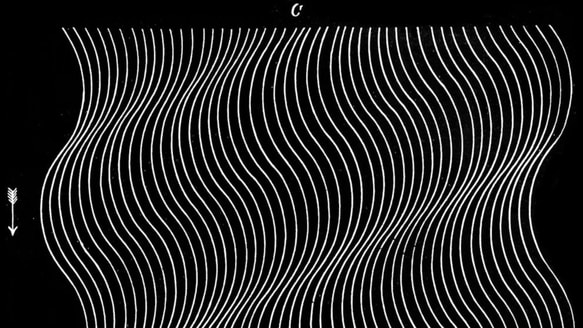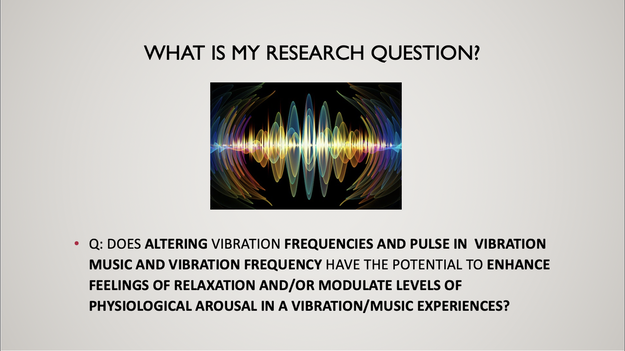|
For my Precursor 1 presentation I am looking at Vibration/Music experiences via the lens of the body. I am using the precursor as an excuse to further persecute the vibration literature for specific heath claims in relation to the body. I am particular interested in component musical affect, such as rhtymn, pulse and freqeuncy. This is somewhat of a issue within the literature as methods for reporting aspects of variables can rather vague within some publications. Nevertheless, I have been narrowing down my research question and I have landed on the following combination of words: The Somatron is one of many vibration/music devices available in the commercial market. This is a point of frustration within the literature as out of the multidtude of devices many are constructed differentialy (which leads to multiple variables to interpret). Each device also has slightly different methods of music/vibration output, which makes it even harder to clarify specific affect within the literature. The Somatron recliner as seen in the video below seems to work via translating the sound to vibrations via specialy designed speakers situated in the chair. This is a point of difference to RMIT's compostional or vibration/music strategy, as within the AKE lab we purposely and manualy craft each vibration/music compostion and the vibrations are not triggered in a speaker, but rather created via a specific vibration accuator. I have comenced the collation of vibration claims and their propertied health effects, from within the systematic review literature. My hope is that I can compare frequency and affect data in the form of a meta-analysis further down the track.
1 - Therapy: ‘The Vibro Acoustic Method’ -pioneered by olav skills - 1989 Method: low vibrations and music in a chair or bed. Music type: relaxation music, slow Vibration range: 30-120 hz Duration: 20 - 30 minutes Claim: decrease in blood pressure, pulse rate, muscle oscillation Diagnostic: Source: Eha Rüütel M. Sc. (2002) The Psychophysiological Effects of Music and Vibroacoustic Stimulation, Nordic Journal of Music Therapy, 11:1, 16-26, DOI: 10.1080/0809813020947803 Therapy: Vibroacoustic Method Method: low vibrations and music in a chair or bed. Music type relaxation music, slow Vibration range/Claim: 40 - 80 hz - most effective vibrations for whole body 40 -60 hz - for reducing spasms 40 - 50hz - pain in the abdomen Duration: Diagnostic: Source: Eha Rüütel M. Sc. (2002) The Psychophysiological Effects of Music and Vibroacoustic Stimulation, Nordic Journal of Music Therapy, 11:1, 16-26, DOI: 10.1080/0809813020947803 Researchers: (Skille, 1989; Skille et al., 1989; Skille & Wigram, 1995) 2 -Therapy: The Vibro Acoustic Method Method: Music type: Vibration range: 40hz (between D#1 & D1) Claim: “considered to coincide with the vibratory frequency of the hypothalamic area and has an essential role in regulating cognitive processes, above all in the mechanisms of selective attention” (p.17 Rüütel, E, 2002) Duration: Diagnostic: Source: Lehikoinen (1994) Researchers: Galambos, Llinas, Makeing, Ribary, Naatanen 3 -Therapy: The Vibro Acoustic Method Method: Music: Spectrum Suite" by Stephen Halperna & Spectrum Suite “with a low frequency pulsating tone with the set of frequency values equal to 68,38,41, 50, 55, and 63 Hz. This selection of frequencies within a relatively wide range was chosen for the following reasons: (a) to study the effects of the low frequency component as a whole and to exclude the specific effects of one concrete frequency (p.18) Vibration range: Duration: Claim: Aparatus: vibroacoustic bed with 6 built in amplifiers. Diagnostic: Blood pressure and pulse rate - digital electronic blood pressure monitor (Omron HEM 405-C). Oscillation fr of relaxation Study: experimental study (24 healthy uni students) 6 x 22 minute sessions of different conditions. “Six different conditions were used: music with two different intensity levels, vibroacoustics (the same music with low frequency sinusoidal pulsating sound) with two different intensity levels, and silence (no stimulation) two times. According to the rotation method 12 different trial plans (different orders of conditions) were used” Source:
0 Comments
Leave a Reply. |
AuthorWrite something about yourself. No need to be fancy, just an overview. Archives
June 2021
Categories |


 RSS Feed
RSS Feed